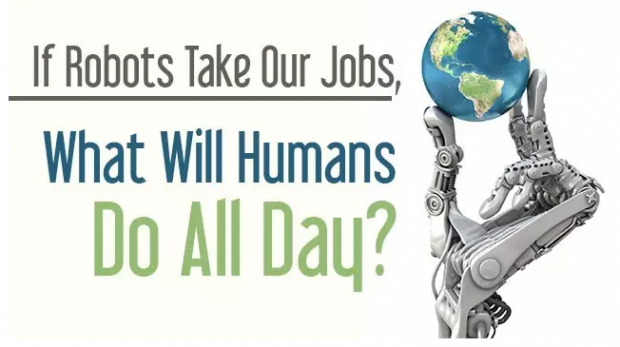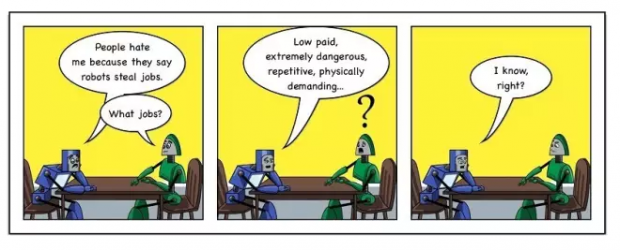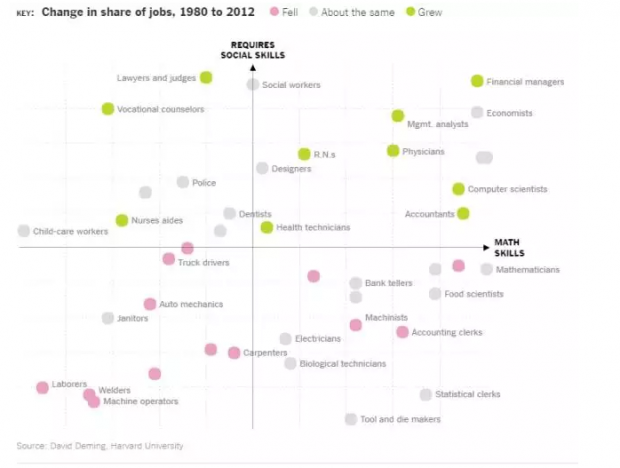原文信息:Acemoglu, D, and P Restrepo (2016), “The Race Between Machine and Man: Implications of Technology for Growth, Factor Shares and Employment”, NBER working paper

序言
“We are being afflicted with a new disease of which some readers may not have heard the name, but of which they will hear a great deal in the years to come — namely, technological unemployment.” (Keynes 1930).
“我们正遭受着一种新的疾病,一些读者可能还没有听说过这个名字,但他们在将来会听到很多,那就是技术性失业”(凯恩斯 1930)。
“Labour will become less and less important… More and more workers will be replaced by machines. I do not see that new industries can employ everybody who wants a job” (Leontief 1952).
“劳动将变得越来越不重要…越来越多的工人将被机器所取代。我很难想象每个想要工作的人都能在新的行业被雇佣”(Leontief 1952)。
在不久的未来,你的工作会被机器取代吗?如果你还没有想过这个问题,没有意识到危机的真实存在和近在咫尺,think again! 根据世界经济论坛Future of Jobs的预测,2020年到来之前,全球将有500万个工作岗位被人工智能,机器人,纳米技术和其他经济因素所取代。我们这个生存环境会越来越数字化和数据驱动(digital, data-driven)。在一个数字化,数据驱动,充满不确定因素的未来,没有人确切知道哪些工作会逐渐消失,哪些现在还闻所未闻的新职业会变得炙手可热。
那么,我们怎样才能让自己和子女具备面向未来的技能(future-proof skills),在与机器的竞争中胜出呢?你的孩子将来长大,你准备给他/她怎样的职业建议?程序员,设计师还是网络营销专家?为了让他/她在将来的职场脱颖而出,从现在开始你应该着重培养他们的哪些技能呢?

文章概要
Acemoglu和Restrepo的这篇工作论文基于两个关键想法:第一,大多数时候,先前由人执行的工作持续不断地被机器所取代,同时,新的工作岗位被创造出来;第二,新的就业机会主要来源于新的较为复杂的任务(new and more complex tasks),在这方面人比资本具有比较优势。
因此,现代劳动市场动态(至少在发达国家)可以想象为这两股力量之间的角逐:一边是机器化和自动化,把工作从人手中夺走;另一边是人不断地创造出新的复杂的任务,增加新的就业岗位。如果前者的速度超过了后者,劳动在国民收入中的比例会下降,技术性失业(technological non-employment)就会产生;如果后者的速度更快,相反的现象就会出现,那就是劳动在国民收入中比重上升和就业的增加。
作者认为,之所以伟大经济学家凯恩斯和Leontief的惨淡预言到了今日还没有实现,是因为人与机器的竞争中第二个力量所起的抗衡作用。展望未来,新技术的浪潮是否会导致劳动力的衰败,要取决于这两股力量之间的角逐情况。

Learn your enemy's language
知己知彼,百战不殆。如果机器要来抢我们的饭碗,我们需要了解我们的竞争对手不是吗?在最近Anthony Goldbloom 的TED talk中-“The Jobs We'll Lose to Machines and the Ones We Won't”,他指出机器已经聪明得超乎我们的想象。机器可以代替医生诊断眼疾,可以代替老师批改学生作文。而且,机器工作起来不知疲倦,判断精准,效率更高。要知道,机器最擅长频繁的,大批量的工作(frequent, high-volume tasks),这类工作我们完全无法与机器竞争。那机器的弱点呢?机器学习需要以大量的历史数据为基础。因此,机器并不擅长创新。人类的创造力(creativity)是我们最大的优势。机器也不身手敏捷,看看餐馆的服务员,你觉得机器人能够替代她们吗?机器不会交流情感,即使能够做家务和看孩子,你愿意让机器人代替保姆或者配偶吗?还有同情心,创造力,领导力,直觉……在这些方面,机器不能与人类竞争,这才是我们的比较优势所在。
哈佛大学经济学副教授大卫的研究显示,孩子在学前班能够学到的社交技能将让他们终生受益。他指出:软技能(soft skills),例如分享(sharing)和谈判能力(negotiation),将是至关重要的技能。未来职场,人们在不同的角色和项目之间切换,酷似学前班教室,在那里孩子们学习社交技巧,比如同情心与合作精神。大卫强调,社交能力(social skills),或者与别人“玩好”(play well) 的能力,是未来职场的制胜法宝。另外,除了这些软技能,硬技能(hard skills)特别是数学能力(math skills)将带来极大回报。所以,要帮助你的孩子在将来万变的职场脱颖而出,关键的只有两样:一,数学能力,二,社交能力。

上图显示,过去二十年增长最稳健的工作是那些结合数学能力和社交能力的就业岗位。而那些既不需要硬技能也不需要软技能的工作,如机器操作和保洁,都在衰退。依靠单一技能(single-skillset)的工作面临的风险最大。另外,1)随着传统职业的衰退和新职业的不断涌现,未来年轻人可能一生要换11个或更多工作;2)自由职业者和兼职工作岗位的增加,要求年轻人diversify their skill sets.
想在退休之前不被机器淘汰,我们需要训练自己的大脑保持学习的能力和速度。保持好奇心,随时准备进行试验的心,并顺应世界正在前进的方向。Be creative.每天尝试点新东西,学点新技能,比如选一条不同的线路回家,做一道风格不同的菜肴,学说一句外语,学用一个新的app……只有这样,我们才能stay ahead of machines. 不要忘了,dream a little, be whimsical, 因为异想天开,心血来潮,也是我们人类的优势呢。
推文人信息
苏亚琴,纽约州立大学布法罗分校经济学博士,现为湖南大学经济管理研究中心助理教授。
Abstract
The advent of automation and the simultaneous decline in the labor share and employment among advanced economies raise concerns that labor will be marginalized and made redundant by new technologies. We examine this proposition using a task-based framework in which tasks previously performed by labor can be automated and more complex versions of existing tasks, in which labor has a comparative advantage, can be created. We characterize the equilibrium in this model and establish how the available technologies and the choices of firms between producing with capital or labor determine factor prices and the allocation of factors to tasks. In a static version of our model where capital is fixed and technology is exogenous, automation reduces employment and the share of labor in national income and may even reduce wages, while the creation of more complex tasks has the opposite effects. Our full model endogenizes capital accumulation and the direction of research towards automation and the creation of new complex tasks. Under reasonable conditions, there exists a stable balanced growth path in which the two types of innovations go hand-in-hand. An increase in automation reduces the cost of producing using labor, and thus discourages further automation and encourages the faster creation of new complex tasks. The endogenous response of technology restores the labor share and employment back to their initial level. Although the economy contains powerful self correcting forces, the equilibrium generates too much automation. Finally, we extend the model to include workers of different skills. We find that inequality increases during transitions, but the self- correcting forces in our model also limit the increase in inequality over the long-run.

0
推荐




 京公网安备 11010502034662号
京公网安备 11010502034662号 